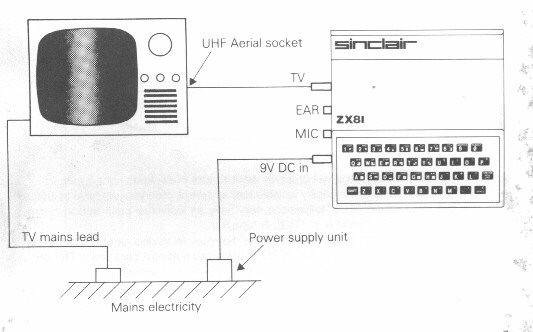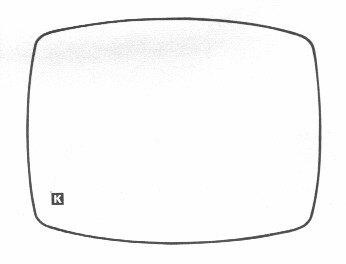
Unpack the ZX81, you will have found
1. This manual.
2. The computer. This has three jack sockets (marked 9V DC IN, EAR & MIC), one aerial socket, & an exposed part of its circuit board where you can plug extra equipment. It has no switches - to turn it on you just connect it to the power supply.
3. A power supply.
This converts mains electricity into the form that the ZX81 uses. If by accident you plug it into the wrong socket in the computer you will do no damage. If you want to use your own power supply, it should give 9 volts DC at 700mA unregulated, & end in a 3.5mm jack plug with positive tip.
4. An aerial lead about 4 feet (120cm) long, which connects the computer to a television.

5. A pair of leads about a foot (30cm) long with 3.5mm jack plugs at both ends. These connect the computer to a tape recorder.
You will also need a television - the ZX81 can work without one, but you won't be able to see what it's doing! It must be a UHF television - if it's not built to receive BBC2 (in the UK) then it's no good.
Later you will need a cassette recorder. This is because when you turn a ZX81 off, all the information stored in it is permanently lost. The only way to keep it for later is by recording it on a cassette tape - you'll see how to do this in chapter 16. You can also buy tapes that other people have prepared, & so run their programs.
When you've got everything together (except the cassette recorder) connect them as shown on previous page.
If your television has two aerial sockets, marked UHF & VHF, then use the UHF one.
Turn the power on, & switch on the television. You now need to tune the television in. The ZX81 operates on channel 36 UHF, & when it is first plugged in and properly tuned it gives a picture like this:

When using the computer, you will probably want to turn the volume right down.
If your television has a continuously variable tuning control, then you just have to adjust it until you get this picture. Many televisions now have an individual push button for each station. Choose an unused one (e.g. ITV2), & tune it in.
If you get stuck with the computer, remember that you can always reset the computer & get back this picture by taking out the '9V DC IN' plug and putting it back again. This should be a last resort, because you lose all the information in the computer.
Note: This description of the television applies to Britain, where there is a UHF system using 625 lines at 50 frames per second. This will work in some other countries (for instance most Western European countries except France). The USA, uses VHF & 525 lines at 60 frames per second.
Now that you've set up the computer, you'll want to use it. If you already know the computer language BASIC, then read appendix C & use the rest of the manual only to clarify the obscure points.
If you're a novice, then the main part of the manual has been written for you. Don't ignore the exercises; many of them raise interesting points that are not dealt with in the text. Look through them, & do any that take your fancy, or that seem to cover ground you don't understand properly.
Whatever else you do, keep using the computer. If you have a question 'What does it do if I tell it such & such?' then the answer is easy: type it in & see. Whenever the manual tells you to type something in, always ask yourself, 'What could I type instead?' & try out your replies. The more of your own stuff you write, the better you will understand the ZX81. (This is called unprogrammed learning.) Regardless of what you type in, you cannot damage the computer.